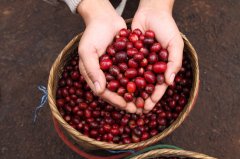The difference between latte and cappuccino
In terms of formula, the definition of latte and cappuccino is not clear. The only difference between the two is that latte has more milk than cappuccino and milk foam is thinner than cappuccino.
When it comes to lattes, the ratio of milk to Italian concentrate fluctuates between 3:1 and 5:1, meaning that if there are 30g Italian concentrate, there are 90g to 150g milk. This ratio often fluctuates. Generally speaking, you will buy more lattes in Starbucks and Costa chains, and less lattes in independent boutique cafes.
Latt é generally refers to caf é Latt é in English-speaking countries, but in Italy, the native country of Italian coffee, latte refers to pure milk, so if you order a cup of "Latt é" in Italy, the waiter will bring you a glass of white milk.
So... That's right, write niu nai, pronounce it latte.
What about cappuccino? The ratio of milk to Italian concentrate is between 2:1 and 3.5 per cent. So in theory, the cappuccino cup will have a smaller mass than the latte. A cup of cappuccino occupies a lot of space is milk foam, milk foam contains a lot of air, so it takes up a lot of volume, but the mass is very small. A small amount of milk makes cappuccino coffee heavier than lattes.
Why do you add so much milk? So isn't it like drinking a big glass of milk when we drink a latte?
As mentioned in Italian concentration, the flavor of Italian concentration is so strong that most people can't control it. Smart and witty Europeans add milk (yes, they do the same with black tea) to weaken the bitterness and add the sweetness of milk.
Well, if you want to understand what they do, you'd better take a look at the elements of these two drinks.
In essence, there is no difference between the two drinks except the milk part. Yinong has been known to everyone, so how is the special milk with "milk foam" in these two drinks made?
Two bar-shaped objects on the coffee machine are the key to making milk bubbles, which we call air needles. One of the effects of air acupuncture is self-evident at this time, that is, heating up! Make the air needle submerge into the liquid surface, then open the valve, and the hot steam enters the liquid to transfer heat, which can heat up a cup of liquid to 80 degrees in 10 seconds. If the milk is heated in this way, the finished product is what we call steamed milk. Steaming milk requires a special vessel, which we call a "milk jar", or a "flower jar". The cylinder body is often bucket-shaped, with a slightly larger opening to facilitate the flow rate of milk poured out. Add cold milk (in the 2 °C freezer) to the milk tank, pour in about 3 °C, then lift the air needle slightly and put it on the milk tank so that the air needle is slightly submerged into the milk surface.
Open the valve again at this time, there will be a sharp "Zizi" sound, heating begins. Interested friends can go to Starbucks. If they listen carefully, they will probably be dizzy by the sound. Milk foam is also called milk foam. The air needle blows high-temperature steam into the milk, and the fat in the milk makes the milk prop up small bubbles. Just like blowing soap bubbles, the outer wall of soap bubbles is soapy water with a special molecular structure, so the outer walls of milk bubbles are supported by fat and protein components in milk. When the milk is steamed, pour it into a large cup with Italian concentrate, and the latte / cappuccino is ready.
Pull flower, Latte Art, is a different kind of charm of the coffee world. Through the coordination of the wrist, make the white slippery and small milk foam float on the coffee oil to form different patterns, so as to achieve the purpose of pleasing the eyes. Because the foam used to make lattes is thinner than cappuccino, fewer bubbles can move more freely. In the case of cappuccino, the bulky nature of thicker milk foam makes it impossible to complete a very complex pattern, so cappuccino's flower drawing
Lattes are often much easier to pull. Latte Art, literally translated as latte art, also shows that latte is exclusive to latte to some extent.
But please note that most Starbucks and Costa stores do not offer pull flowers, and they often produce coffee in packaged paper cups, so the quality of pull flowers has no effect on their sales, and you will not feel any difference from pulled flowers when drinking in front of the mouth of the packaged cup. If you want to see the cool art of flower drawing, please look for an independent boutique cafe, where the monsters are there.
Through a special way of pulling flowers, smooth milk and Italian concentrate finally merge into the final cup of latte, or cappuccino. In the meantime, hard work cannot be explained by a simple coffee structure diagram. I hope everyone will treat each cup of coffee seriously, not only for the 20 or 30 yuan paid, but also for the baristas and coffee farmers to provide a lot of work behind that cup.
With all that said, how do lattes and cappuccinos taste? What's the difference?
I would like to analyze the taste and taste of the two in a more objective and simple way.
Latte, because its milk content is higher than cappuccino, the taste of coffee is more diluted and milky. For those of you who hate the bitter taste of coffee, you might as well start with the latte and look for the subtle flavor of coffee besides bitterness in the thinnest coffee.
Cappuccino, less milk, and a large part of the delicate milk foam, its coffee flavor will naturally be much more rich, coupled with thick delicate milk foam, drinking an authentic cappuccino is like plunging into a soft Simmons. The palate is thick and delicate, with a heavier flavor of coffee. For those of you who prefer espresso, I will give you a cappuccino between latte and cappuccino.
Friends, whether in a big chain like Starbucks or in small boutique cafes, please try not to add sugar to lattes or cabs, or at least taste what real coffee tastes like before you add sugar. Numerous coffee experts agree that sugar is the killer of the original flavor of coffee. Coffee drinks that have already been diluted many times by milk, plus packets of white sugar and brown sugar?
So, with so much milk added, can lattes and cabs really reflect the quality of coffee beans?
The answer is yes. Even with so much milk, the extremely strong Italian concentrate is not completely covered. Of course, after adding milk, people's tongue's ability to perceive the flavor of coffee itself decreases greatly, but that doesn't mean that people can't taste the coffee. Even for the layman, when faced with a latte made of commercial beans and a latte made of fine beans, he can still find out which one is better, but the layman may not be able to tell what is good about the fine beans for the time being.
The Seesaw Cafe in Shanghai once launched the SOE Yega Sheffield latte, and friends still found Yega's unique floral fragrance in the latte filled with milk, which really illustrates the effect of coffee beans on milk coffee. If coffee beans really have no effect on milk coffee, why are boutique cafes still studying better Italian combinations? Of course, although milk coffee does not eliminate the tongue's ability to perceive flavor changes, it at least greatly reduces its perception.
People in the industry call coffee lattes with milk as milk coffee or milk-based coffee. From a professional point of view, these milk-based coffee is not as valuable as black coffee. Those who do coffee research must study pure coffee, but they should not study pure coffee + milk. In the eyes of picky experts, milk coffee should be called coffee drink.
Although not highly rated in the professional field, the milk coffee has the upper hand in the fields of art and life. Strange and beautiful flowers always make coffee pleasing to the eye, diluted coffee is more acceptable to people who are afraid of bitterness, and sweet and delicate steamed milk makes it easier to taste. Some people commented that milk coffee is a perfect combination of the two most wonderful things in the world: coffee and milk. Drinking milk coffee has become a leisurely yearning and emotional attitude towards life.
If so, pure coffee tends to the technical field, then the milk coffee tends to the life field. Which is better or worse? Because, after all, coffee is drunk by people, people determine the definition of the word "coffee". Individual subjective imposition does not make much sense to the broad masses. Professional or unprofessional? Whoever cares about you, it tastes good.

Important Notice :
前街咖啡 FrontStreet Coffee has moved to new addredd:
FrontStreet Coffee Address: 315,Donghua East Road,GuangZhou
Tel:020 38364473
- Prev

Classification and causes of defective beans in Fine Coffee SCAA
The growth environment of boutique coffee beans also has higher requirements. Generally grow at an altitude of 1500 meters or even more than 2000 meters above sea level, with appropriate precipitation, sunshine, temperature and soil conditions. Some world-famous coffee beans also have a special geographical environment, such as the alpine clouds in the Blue Mountains, the free shade provided by the afternoon clouds in Kona, and the volcanic ash soil in Antigua.
- Next
Coffee steaming principle The role of hand steaming
About coffee steaming. Many baristas or enthusiasts have different opinions on the way, time and amount of steaming. They learn the process of steaming coffee from the physical principles of steaming coffee. When coffee beans are ground into coffee powder particles, the coffee powder particles we see with the naked eye are whole, but in fact, the microscopic structure of coffee powder is actually a honeycomb like knot.
Related
- Beginners will see the "Coffee pull flower" guide!
- What is the difference between ice blog purified milk and ordinary milk coffee?
- Why is the Philippines the largest producer of crops in Liberia?
- For coffee extraction, should the fine powder be retained?
- How does extracted espresso fill pressed powder? How much strength does it take to press the powder?
- How to make jasmine cold extract coffee? Is the jasmine + latte good?
- Will this little toy really make the coffee taste better? How does Lily Drip affect coffee extraction?
- Will the action of slapping the filter cup also affect coffee extraction?
- What's the difference between powder-to-water ratio and powder-to-liquid ratio?
- What is the Ethiopian local species? What does it have to do with Heirloom native species?

